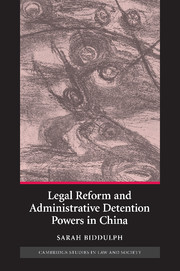Book contents
- Frontmatter
- Contents
- Preface
- Abbreviations
- Part 1 Introduction and conceptual framework
- Part 2 Social order and administrative detention
- 3 Historical antecedents: the 1950s and administrative detention
- 4 Social order, the ‘Hard Strike’ and administrative detention powers
- 5 Revival of administrative detention in the reform era: prostitutes and drug addicts
- 6 Re-education through Labour
- Part 3 Legal reform and its impact on administrative detention
- Part 4 Analysis and conclusion
- Appendix 1 Index of Legislation, administrative regulations, rules, normative documents, Party documents, speeches and cases
- Bibliography
- Index
3 - Historical antecedents: the 1950s and administrative detention
Published online by Cambridge University Press: 27 July 2009
- Frontmatter
- Contents
- Preface
- Abbreviations
- Part 1 Introduction and conceptual framework
- Part 2 Social order and administrative detention
- 3 Historical antecedents: the 1950s and administrative detention
- 4 Social order, the ‘Hard Strike’ and administrative detention powers
- 5 Revival of administrative detention in the reform era: prostitutes and drug addicts
- 6 Re-education through Labour
- Part 3 Legal reform and its impact on administrative detention
- Part 4 Analysis and conclusion
- Appendix 1 Index of Legislation, administrative regulations, rules, normative documents, Party documents, speeches and cases
- Bibliography
- Index
Summary
INTRODUCTION
From the late 1940s the CCP grappled with the problems of consolidating and institutionalising its political power and restoring order. The public order situation in newly liberated cities was described as generally ‘chaotic’. From its efforts to deal with this chaotic situation at the same time as working to entrench its political power, the Party state evolved a comprehensive social order strategy in which administrative detention played an important role. In the official imagination at least, this social order strategy was so successful that the period between 1952 and 1960 was idealised as a time of ‘peace and prosperity’.
The ways in which the tasks of establishing political and social order were eventually achieved continue to influence approaches to the maintenance of social order today. They comprised strategies of education and reform, the use of administrative measures and the exercise of dictatorship, that is, the severe punishment of crime and political offences.
The political environment in which the comprehensive programme to manage social order developed in the late 1970s was different from that of the 1950s. The social and economic situation in which it was implemented was also radically altered. However, the contemporary public order programme draws on a similar mix of elements as those attributed to the 1950s and Mao Zedong: education and reform, the use of administrative measures and the severe punishment of crime.
- Type
- Chapter
- Information
- Publisher: Cambridge University PressPrint publication year: 2007



